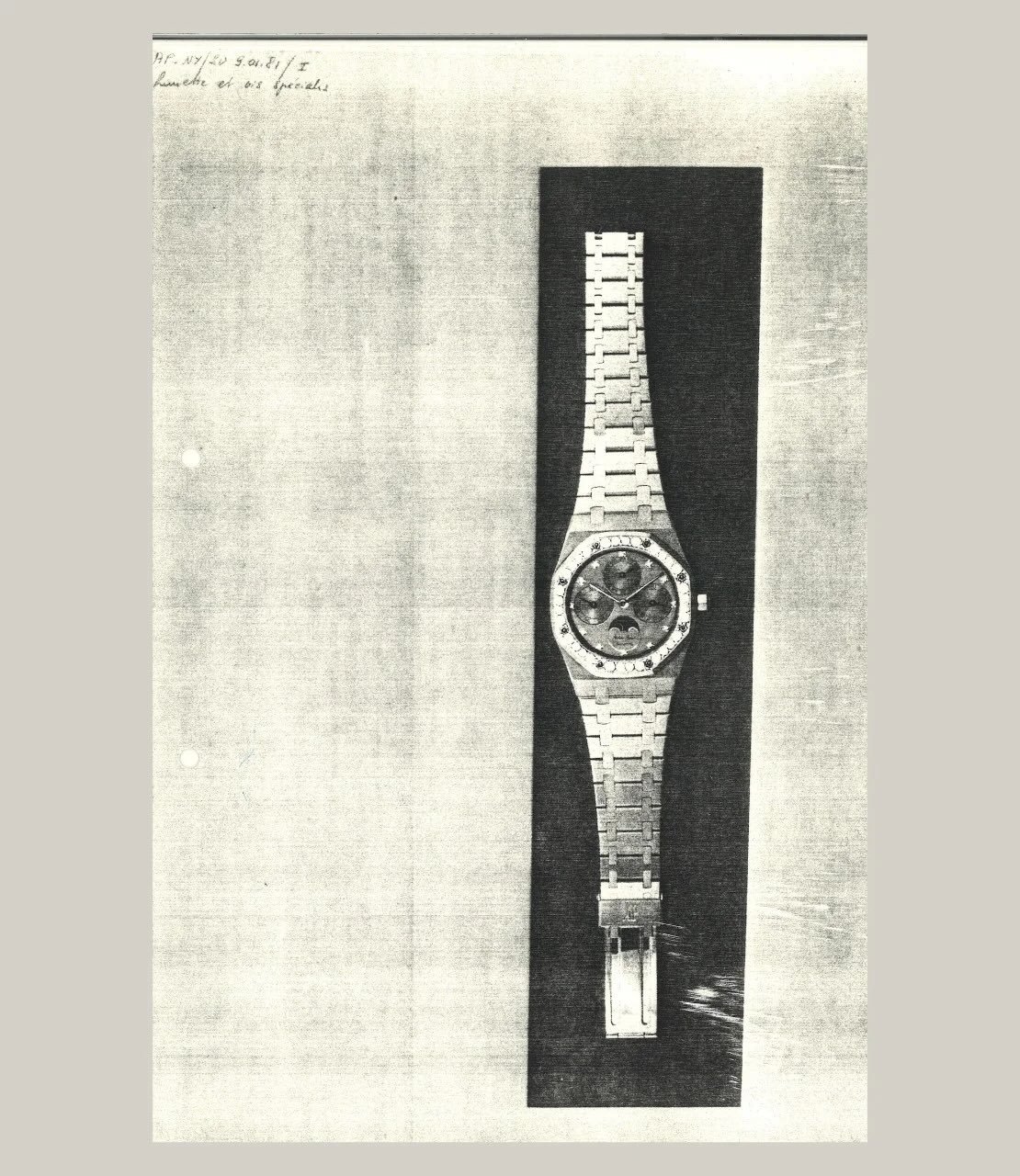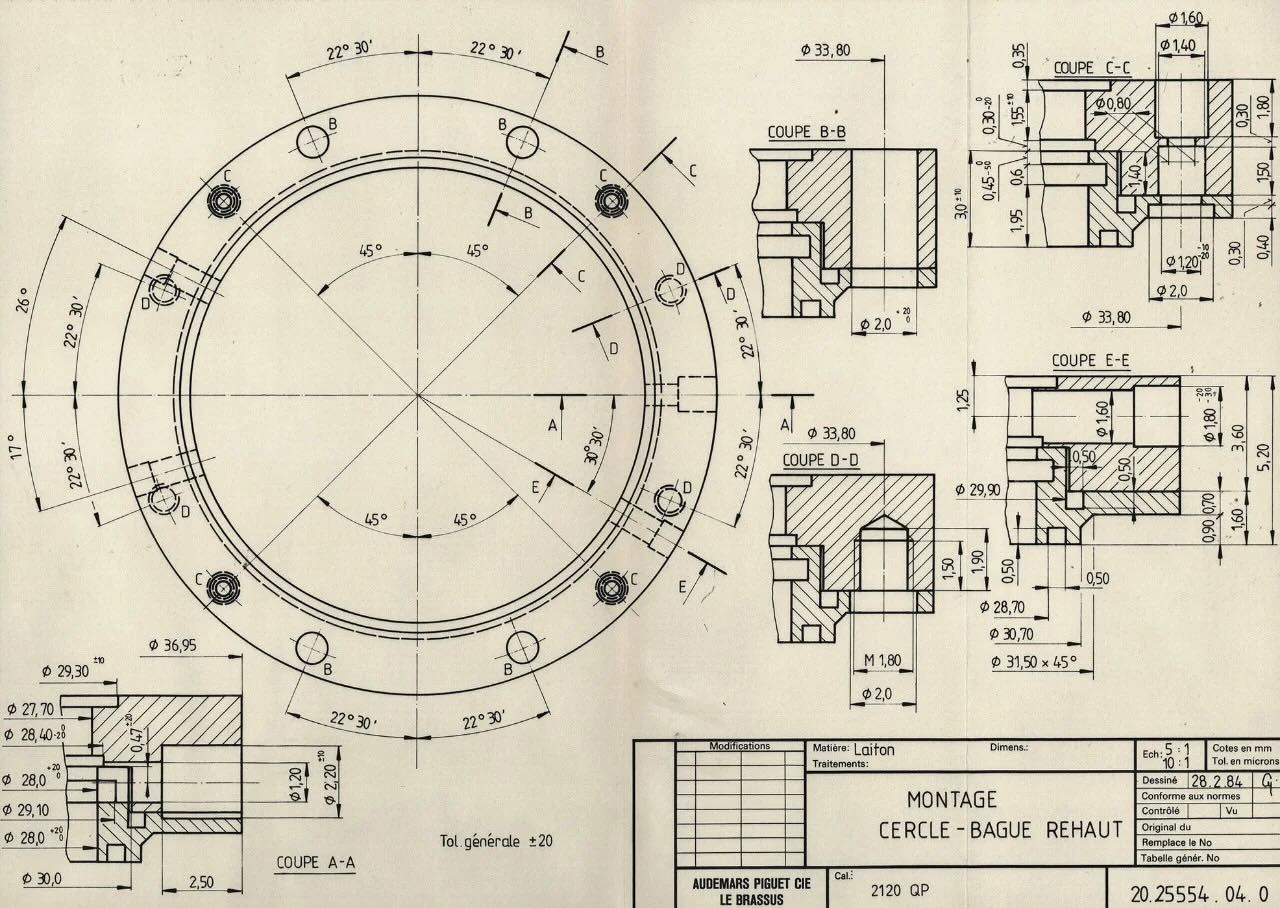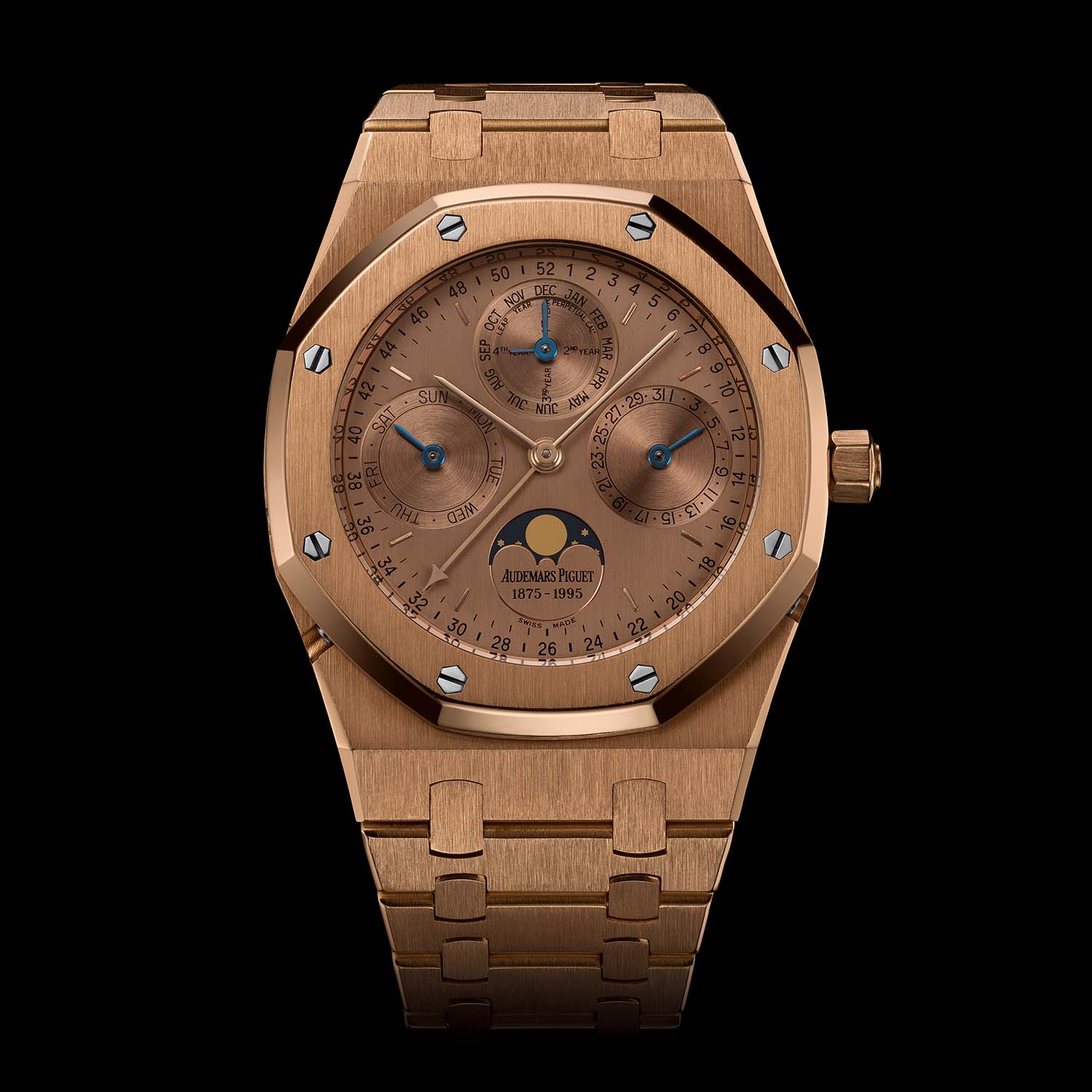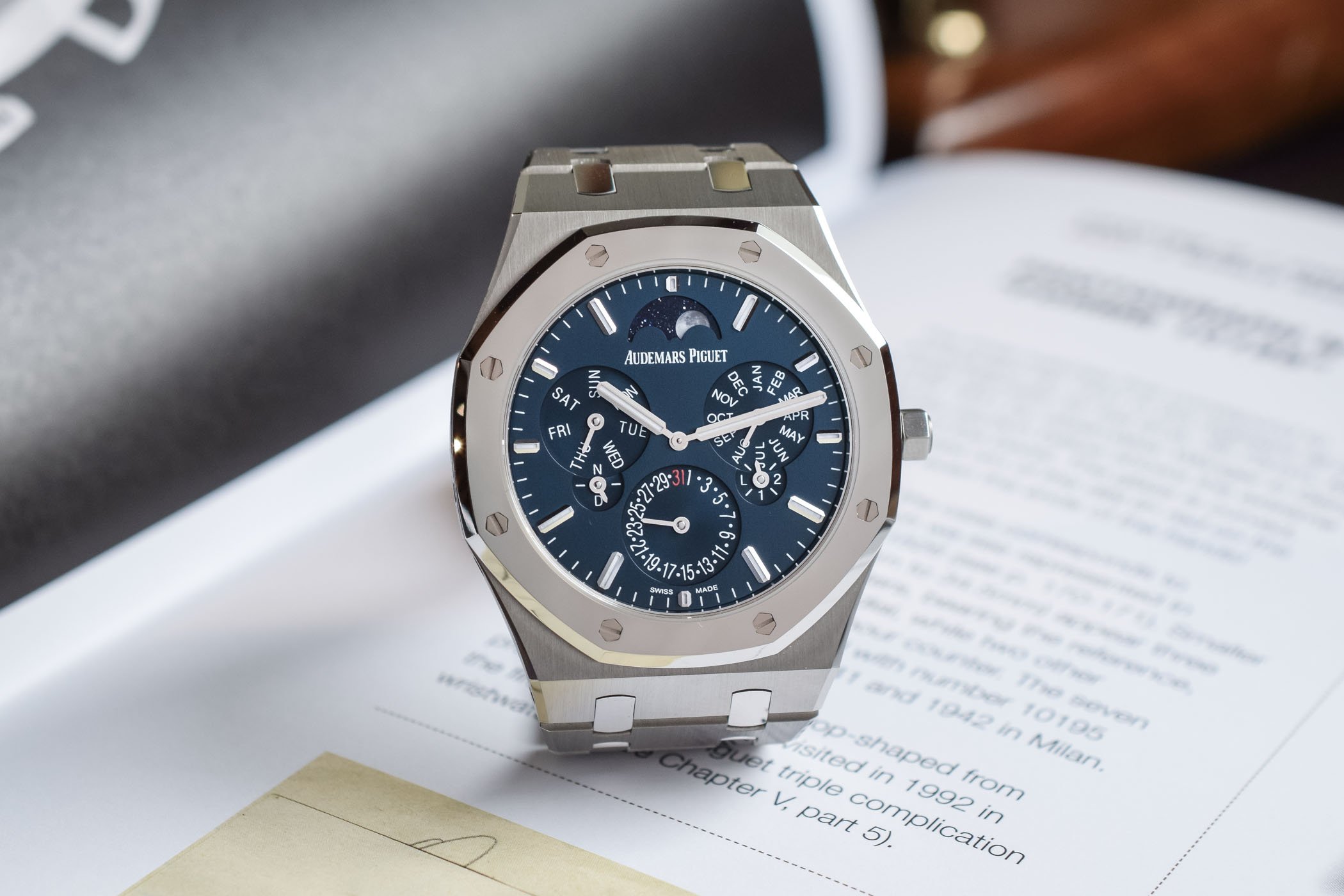
Try our newest merchandise
In watchmaking, few problems command such reverence as the perpetual calendar, and few manufacturers have woven it into their id as totally as Audemars Piguet. Whereas the model’s mastery of this calendar complication dates again to the early twentieth century, its true renaissance got here by way of a most surprising path: the Royal Oak sports activities watch. Allow us to journey by way of its evolution, reference by reference, decade by decade, to witness how Audemars Piguet reworked technical data into wearable artistry.
The First Issues within the Royal Oak Line
The perpetual calendar, which is a lot part of how we understand the model and the enduring sports activities watch now, has been a cherished complication for Audemars Piguet for the reason that firm was established. But, of the 208 calendar wristwatches delivered between 1924 (with the oblong watch quantity 27819, the primary AP calendar wristwatch) and 1969, solely 12 featured a perpetual calendar, all produced in 1955 and 1957 for the legendary Mannequin 5516, the first-ever wristwatch to point the leap-year cycle.

When Audemars Piguet Royal Oak burst onto the scene in 1972 with the reference 5402ST, it surprised the trade with its daring design and opulent tackle the metal sports activities watch. It additionally stored issues mechanically easy, that includes solely a date show. However the tides shifted a decade later because the Royal Oak assortment started embracing problems, beginning with calendar shows.


Step one was modest. In 1983, Audemars Piguet launched the Royal Oak Day-Date, reference 5572. Nicknamed “The Owl” resulting from its giant twin subdials for the day and date indications, this 36mm watch was powered by the calibre 2124/2810, a self-winding motion with a Jaeger-LeCoultre base. Although it lacked the sophistication of a perpetual calendar, its reputation signalled a robust market urge for food; over 600 models had been delivered earlier than it appeared within the model’s official catalogue in 1984.


A moon section model of the Royal Oak joined the gathering the next yr, ensuing within the reference 25594, the Royal Oak Day-Date Moon Part. Produced for over 20 years, it grew to become one of many longest-running fashions within the Royal Oak household. However Audemars Piguet was already setting its sights larger.
Transferring to the Perpetual Calendar
Within the mid-Seventies, because the Swiss watch trade reeled from the quartz disaster, three Audemars Piguet watchmakers, Michel Rochat, Wilfred Berney, and Jean-Daniel Golay, collaborated to develop a contemporary, ultra-thin perpetual calendar motion appropriate for wristwatches. Their purpose was formidable: convey one in every of watchmaking’s most storied problems into the modern period. Their proposal gained over then-Normal Supervisor Georges Golay, who greenlit the manufacturing of 159 items, a unprecedented present of confidence for a excessive complication.
Unveiled in 1978, the ensuing Mannequin 5548 featured the calibre 2120/2800, the thinnest self-winding perpetual calendar motion ever made on the time, at 3.95mm thick. It mixed the two.45 mm-thick Calibre 2120 base with a 1.5mm perpetual calendar module by Dubois Dépraz, mounted beneath the dial. The mannequin was a industrial and significant success, and within the years that adopted, the motion, monitoring 4-year (1,461-day) cycles and which didn’t characteristic bissextile year indicator however was programmed mechanically to account for the leap-year, would seem in additional than 110 totally different references, with complete manufacturing nearing 7,300 models, together with 791 openworked examples.


Nonetheless, integrating this calibre into the Royal Oak case proved difficult. Calibre 2120/2800 demanded a 39 mm case, and manufacturing of the unique 39mm Royal Oak Jumbo fashions was already in decline. It wasn’t till 1981 that the thought of a Royal Oak Perpetual Calendar was revived, prompted by curiosity from the U.S. market. An inner sketch from that yr reveals a Royal Oak Perpetual Calendar prototype with a gem-set bezel, drawn over a photograph of Ref. 5402 and initialled by Gross sales Director Steven Urquhart.


Audemars Piguet’s technical workplace took on the undertaking in 1983. The challenges had been appreciable: the 2120/2800 motion was 0.9mm thicker than the 2121 calibre used within the authentic Royal Oak. Case modifications needed to be each refined and functionally strong.
Engineering the Royal Oak Perpetual Calendar
The bezel was raised by 0.6mm to suit the thicker motion, and the sapphire crystal was dramatically thinned from 2mm to 0.9mm, which required abandoning the unique heel-type attachment system in favour of a domed bezel at a 45-degree angle.
The Royal Oak’s hexagonal screws, a signature design factor, additionally sophisticated issues. The calendar correctors needed to navigate across the screws and the thick monobloc case construction. Ultimately, the screws had been decreased in diameter and at 10 o’clock and 4 o’clock, they grew to become ornamental to make room for pushers; the motion wanted one at 10 o’clock (date/day), at 8 o’clock (day solely), and 4 o’clock (moon section), all operated with a small stylus. The massive rubber gasket utilized in Ref. 5402 was changed with a steel ring flanked by two O-rings to take care of water resistance.


The Tapisserie-pattern dial needed to go. Instead, Audemars Piguet used a flat baseplate like the sooner reference 5548, with 0.1mm recesses to accommodate calendar subdials. The utilized emblem was omitted, and the hour markers slimmed, all to protect legibility on the condensed dial floor and to maintain it as skinny as potential.
Regardless of the complexity, the outcome, often known as reference 25554, measured 7.5mm thick, solely 0.4mm greater than the time and date Royal Oak Jumbo 5402ST.
The Royal Oak Perpetual Calendar Reference 25554: A Milestone
Reference 25554 was launched on the Basel Truthful in April 1984, initially in metal (then designated 5554). But the primary mannequin offered was really in yellow gold (Ref. 25554BA), delivered in December of that yr. Metal fashions adopted in early 1985.


Manufacturing numbers had been telling. The yellow gold model was essentially the most prevalent, with over 200 watches delivered in 1984-1986. Solely 46 had been delivered in metal in 1985 (49 in complete made in 1983-1993), every with a matte gray dial and instances repurposed from the 5402ST Collection D, bearing their authentic and new reference numbers. Only one platinum model was made (Ref. 25554PT, 1986), fitted with a deep blue dial.
Curiously, all metal variations of the Royal Oak Perpetual Calendar Ref. 25554ST had been completely allotted to the Italian market. They had been distributed by Alessandro Villa, who took over the area’s operations in 1985 from the ailing SSIH group – an early supporter of the Royal Oak that finally succumbed to the aftermath of the quartz disaster.


Between 1984 and 1992, 279 items of Ref. 25554 had been produced. Its industrial success was instrumental in establishing the Royal Oak Perpetual Calendar as a mainstay within the Audemars Piguet lineup and set the stage for the mannequin’s subsequent evolution.
The Reference 25654 and following fashions: Refined Refinements, Sustained Success, Uncommon Variants
In 1987, Audemars Piguet launched the Royal Oak Perpetual Calendar Reference 25654. Whereas visually like its predecessor, it introduced necessary technical refinements. The case was barely thicker, 8.3mm as a substitute of seven.5mm, to accommodate a bigger steel casing ring and a extra strong rubber gasket. A 3rd case variant would ultimately embody a sapphire caseback, growing complete thickness to eight.8mm.




Regardless of these structural adjustments, the general aesthetics and motion (Calibre 2120/2800) remained largely unchanged from the Reference 25554. Nonetheless, the 25654 confirmed the rising enchantment of the complication throughout the Royal Oak line. Over the following 12 years, 851 items had been produced: 315 in metal, 430 in yellow gold, 68 in two-tone, and 38 in platinum.


Earlier than the Reference 25654 grew to become the mainstay of the Royal Oak Perpetual Calendar line, Audemars Piguet launched a sequence of fashions that enriched the gathering’s range and collector enchantment. In 1985, the producer created the 25624BA, a one-of-a-kind yellow gold piece adorned with a diamond-set bezel, which was offered within the Center East. In 1986, AP launched the 25636, an openworked perpetual calendar that includes a sapphire dial. This design provided a transparent view of the finely completed Calibre 2120/2800, highlighting the extent of expertise usually hidden behind stable dials. Greater than 300 examples had been produced: 156 in yellow gold, 61 in chrome steel, and smaller numbers in platinum, rose gold, and two-tone configurations. Noteworthy among the many latter had been the Reference 25636RP, that includes a rose gold case with a platinum bezel and centre hyperlinks and a chrome steel mannequin with matching platinum accents.


That very same yr, the Reference 25651BA, a singular openworked yellow gold piece, was produced and offered in Hong Kong, additional reinforcing AP’s dedication to tailored creations for key markets.
Constructing on the platform of the reference 25654, Audemars Piguet launched a number of extra distinctive editions between 1989 and 1994. Two examples of the 25687 in yellow gold had been crafted in 1989, whereas a platinum model appeared in 1994. Additionally, in 1994, the 25773SA was launched as a singular creation that merged sporty aesthetics with horological complexity.


One other standout sequence was the Reference 25686, which launched a show caseback, produced between 1989 and 1997. This mannequin featured quite a lot of dial interpretations with many colors and finishes. Reference 25686 launched the guilloché sample often known as T21 Tapisserie into the Royal Oak Perpetual Calendar world, the finely engraved Tuscany blue dial and the mother-of-pearl dials. A complete of 299 items had been made throughout a variety of supplies, together with yellow gold (BA), platinum (PT), chrome steel (ST), rose gold with platinum accents (RP), full rose gold (OR), metal with platinum (SP), and platinum with rose gold (PR). Two extra notable one-offs embody the Reference 25694PT, crafted in platinum in 1990, and the Reference 25775SA, launched in 1994.
It will likely be flawed to not point out the Girls’ Royal Oak Perpetual Calendar 33mm Reference 25800 (1996), powered by calibre 2141/2806, which was particularly developed for this reference and encompasses a bissextile year indicator on the dial.


A Decade of Affect and the Highway to the Leap Yr
From its debut in 1984 by way of the mid-Nineties, Audemars Piguet offered some 1,746 Royal Oak Perpetual Calendar watches powered by the Calibre 2120/2800. This achievement represented successful for the model and contributed significantly to its revenues: in 1984, the reference 25554 was priced at USD 27,000, and in 1988, the metal reference 25654 was provided at CHF 24,900.
It’s value noting that each one first-generation Royal Oak Perpetual Calendars shared a key limitation: they lacked a bissextile year indicator. This omission was intentional, a tradeoff made to attain the ultra-thin profile of Calibre 2120/2800. But, the bissextile year cycle, first launched in wristwatches by Audemars Piguet within the legendary Mannequin 5516, was too iconic a legacy to stay absent for lengthy. That return to type would arrive in 1995, ushering in a brand new chapter for the Royal Oak Perpetual Calendar.
The Leap-Yr Indicator and the Reference 25810
In 1995, to have a good time its a hundred and twentieth anniversary, Audemars Piguet launched a landmark reference that may redefine its perpetual calendar line: the Royal Oak Perpetual Calendar Reference 25810 in rose gold. This restricted version of simply 120 items was powered by the up to date Calibre 2120/2801, marking the return of the leap-year indicator, a complication seen on the historic Mannequin 5516, the world’s first wristwatch to show this perform.


This refined motion featured a coaxial hand mounted on the month subdial at 12 o’clock, permitting the leap-year cycle to be learn intuitively. The rose-gilded dial had a clean, brushed end that drew the attention towards the finely balanced subdials. The day, date, month, and bissextile year had been organized throughout the higher half of the dial, every proven with slender blued fingers. At 6 o’clock, the moon section show shared area with the Audemars Piguet emblem and an inscription commemorating the corporate’s 120-year historical past, “1875–1995.”
A singular characteristic of this anniversary version was a central arrow-tipped hand that pointed to the week quantity on the outer fringe of the dial. This elegant and sensible contact was unique to Ref. 25810. This element wouldn’t be carried over to the common manufacturing model 25820, which adopted a number of years later.


In 1998, Audemars Piguet launched the reference 25820, produced in numerous configurations, reflecting each technical refinement and aesthetic experimentation. Chrome steel variations got here with 5 dial choices: a clean silvered dial, a white tapisserie dial, and three distinct shades of blue, all with AP’s signature tapisserie texture. There have been additionally two dial variants in yellow gold, two platinum editions, and three steel-and-platinum hybrids.


Among the many most coveted releases had been the unique combos in tantalum, every paired with both rose gold, yellow gold, or platinum. The tantalum-platinum model, specifically, earned a particular place amongst collectors for its putting look and rarity, usually thought to be the head of the Royal Oak Perpetual Calendar lineup. Later within the decade, Audemars Piguet reintroduced the skeletonised Royal Oak Perpetual Calendar, a format first showing with the reference 25636.


The reference 25829 debuted in a number of case materials variations: metal, yellow gold, rose gold, platinum, and the tantalum combos, all showcasing the ending of Calibre 2120/2802, remodeling the dial right into a window onto AP’s watchmaking mastery. By these fashions, Audemars Piguet stored its perpetual calendar legacy and ushered it into a brand new period, balancing custom with evolution and performance with type.
The 26574 and the Calibre 5134, The Fashionable Royal Oak Perpetual Calendar
In 2015, Audemars Piguet launched one other milestone within the Royal Oak Perpetual Calendar lineage with the launch of the reference 26574. This mannequin marked the primary main redesign of the perpetual calendar in a long time. It was housed in a newly sized 41mm case, a departure from the normal 39mm diameter that had outlined the mannequin since its inception. Whereas the debut of a 41mm Royal Oak could have appeared like a daring shift, it adopted a gradual pattern, first established in 2012 when Audemars Piguet elevated the case dimension of the usual Royal Oak Computerized (non-Jumbo) to 41mm with the time-and-date reference 15400.


Driving this evolution was the Calibre 5134, an up to date perpetual calendar motion engineered to accommodate the bigger case dimensions. Barely thicker than its predecessor (now 4.31mm versus the earlier 3.95mm), the brand new motion offered an uncommon week indicator, learn by way of a centrally mounted hand sweeping over a scale on the outer fringe of the dial.


Regardless of the added perform and elevated diameter, Audemars Piguet managed to protect the slimness of the Royal Oak case. The watch measured 9.5mm thick, solely marginally greater than the earlier 9.3mm, sustaining the elegant profile collectors count on from the road.
Greater than only a visible replace, the 26574 introduced again curiosity to the Royal Oak Perpetual Calendar, reaffirming its standing as one of many cornerstones of Audemars Piguet’s horological id.




Audemars Piguet’s fashionable chapter of the Royal Oak Perpetual Calendar maybe started in 2017 with the launch of Ref. 26579CE, the primary all-ceramic QP within the assortment. Clad fully in black ceramic, together with the bracelet, and completed to the model’s signature commonplace of ending, it set a brand new benchmark for ceramic excessive problems. In 2019, the openworked reference 26585 in black ceramic marked the return of the skeleton QP, adopted by a white ceramic mannequin and, in 2022, a blue ceramic version, all powered by Calibre 5134/5135 with week indication intact.
Slimmer than Slim, the Royal Oak Perpetual Calendar RD#2 and the 26586
2018 marked a leap: the disclosing of the RD#2 prototype in full platinum, an idea watch reimagining the perpetual calendar in a case simply 6.3mm thick, practically 1mm slimmer than even the unique Royal Oak ref. 5402.


On the coronary heart of the RD#2 was Calibre 5133, a radical re-engineering utilizing the traditional 2120 base. As a substitute of the traditional stacked module, the perpetual calendar features had been totally built-in and unfold horizontally, permitting a flatter structure. This motion shifted the moonphase to 12 o’clock, repositioned the date to six, day to 9, and months to three, with bissextile year and day/evening indications showing at 4 and eight o’clock, respectively. Notably, the week show was omitted, however the motion’s ingenuity drew common reward.


In 2019, AP launched the manufacturing model because the reference 26586, debuting in titanium with a platinum bezel and center hyperlinks. At launch, this watch was the thinnest perpetual calendar ever produced, up till Bulgari took the title again with its Octo Finissimo Perpetual Calendar. Subsequent variants of the Royal Oak Selfwinding Perpetual Calendar Extremely-Skinny included a full titanium version in 2023 and a yellow gold China-exclusive mannequin in 2024.
The top of Calibre 5134, and the brand new era Ref. 26674 with calibre 7138
By 2024, AP revealed the final look of Calibre 5134 within the John Mayer restricted version Ref. 26574BC, asserting its retirement. Taking its place is the next-generation Calibre 7138, launched as a part of the model’s one hundred and fiftieth anniversary within the Royal Oak Perpetual Calendar Selfwinding Ref. 26674, accessible in chrome steel and sand gold.


Calibre 7138 builds on the ultra-thin, high-frequency base of the 7121, launched in 2022 for the fiftieth anniversary Jumbo reference 16202ST, integrating a perpetual calendar module derived from RD#2’s 5133, however with enhanced user-friendliness. The motion measures simply 4.1mm thick and replaces all recessed correctors with a single, four-position crown. Due to a patented keyless works system and cam integration straight into the calendar wheels, each perform, together with day, date, month, week, bissextile year, and moonphase, is crown-adjustable, synchronised, and guarded in opposition to harm even throughout date-change hours.


The dial of the brand new reference 26674 has additionally developed. Week 1 now sits at 12 o’clock, aligned with each “Monday” and the numeral “1” of their respective sub-dials for intuitive studying. A 24-hour indicator has been added throughout the day sub-dial, alongside a purple no-correction arc between 9 PM and three AM. The date show at 3 o’clock encompasses a progressive step mechanism and a variable-tooth wheel to enhance spacing and legibility. The moonphase, in the meantime, now reveals a photorealistic Moon rendered from NASA imagery.


As of 2025, the perpetual calendar spans ten Royal Oak references, together with two Grand Issues, and encompasses a various mixture of supplies and executions. These embody the metal and sand gold Ref. 26674, the yellow gold and titanium 26586 Extremely-Skinny fashions, the “John Mayer” 26574BC, and the openworked 26585 sequence, which most not too long ago added the “Cactus Jack” in brown ceramic and Titanium/BMG Royal Oak Perpetual Calendar Openworked one hundred and fiftieth Anniversary (the final with this skeleton motion, earlier than a brand new one seems), all to verify that the legacy of the Royal Oak QP continues to evolve, mechanically refined, materially various, and unmistakably Audemars Piguet.


Over 4 a long time, the Royal Oak Perpetual Calendar has grown from a daring technical experiment into one in every of Audemars Piguet’s defining sequence. From the ultra-thin marvels of the Nineteen Eighties to right this moment’s ceramic and crown-adjustable calibres, every era has pushed the boundaries of innovation whereas honouring a deep-rooted heritage.


This enduring lineage is a testomony to engineering excellence, and it mirrors the model’s potential to evolve, adapt, and encourage. As we glance at the moment with Calibre 7138 and Ref. 26674, the Royal Oak Perpetual Calendar stays a logo of what Audemars Piguet does finest, rewriting the principles whereas respecting custom. For extra particulars, please go to audemarspiguet.com.
https://monochrome-watches.com/history-of-the-audemars-piguet-royal-oak-perpetual-calendar-in-depth-review/

3 Pack Screen Protector Film, compatible with Rado R12.413.803 TPU Guard for Smart watch Smartwatch ( Not Tempered Glass Protectors )











